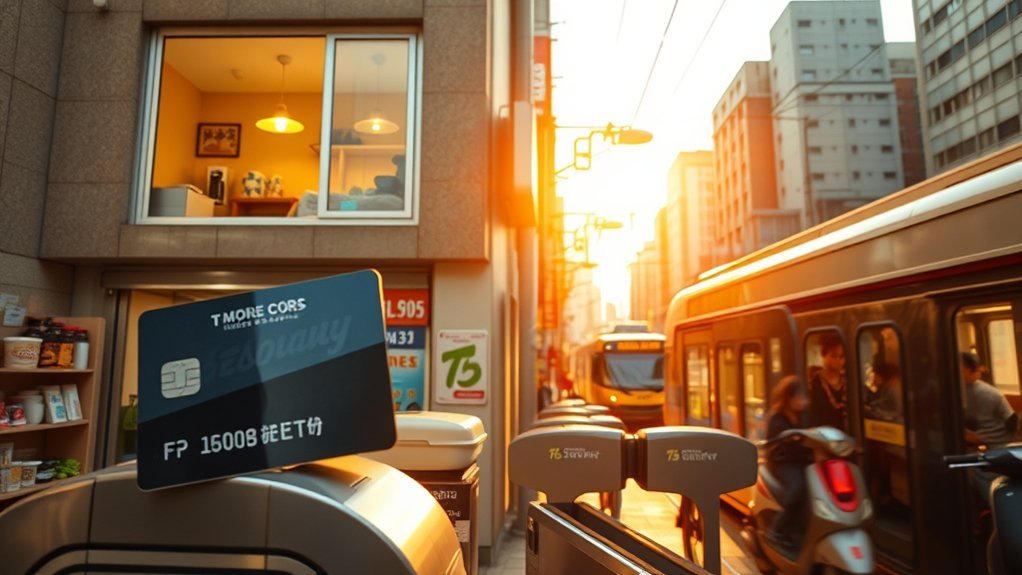You’ll typically spend about ₩1.2–1.5 million monthly as a single in Seoul, with rent driving most of that cost depending on neighborhood and housing type (jeonse, wolse, officetel, goshiwon). Expect one-bedroom rent ≈ ₩1.3M in the city center and ≈ ₩790K outside; utilities, internet and mobile add roughly ₩100K–₩150K. Public transit fares are ₩1,250–1,500 per trip and KTX trips run about USD 45–50. Keep going to see detailed breakdowns and saving tips.
Monthly Budget Breakdown: Typical Expenses for Singles and Families

Want a quick snapshot of what living in Seoul will cost you each month? You’ll see singles typically budget about $1,202 monthly including rent, while a family of four often plans roughly $4,022. Rent is a major component: one-bedroom units average $833/month in the city center and $486 outside it, though many residents use jeonse deposits (60–70% of property value) or wolse arrangements with smaller deposits and monthly rent. Utilities, internet, and maintenance usually add $103–$150 for a single person; internet runs about $18–$19 and mobile plans $42–$53. Transportation costs can be modest with public fares starting near $1.30 per ride, and a monthly subway/bus pass averages around $152. When you build a practical monthly budget, prioritize rent or deposit strategy first, then factor in utilities and transportation to determine whether Seoul’s central living premium fits your finances. Additionally, understanding related costs associated with living can help provide a clearer financial picture.
Housing Options: Jeonse, Wolse, Officetels and Goshiwons
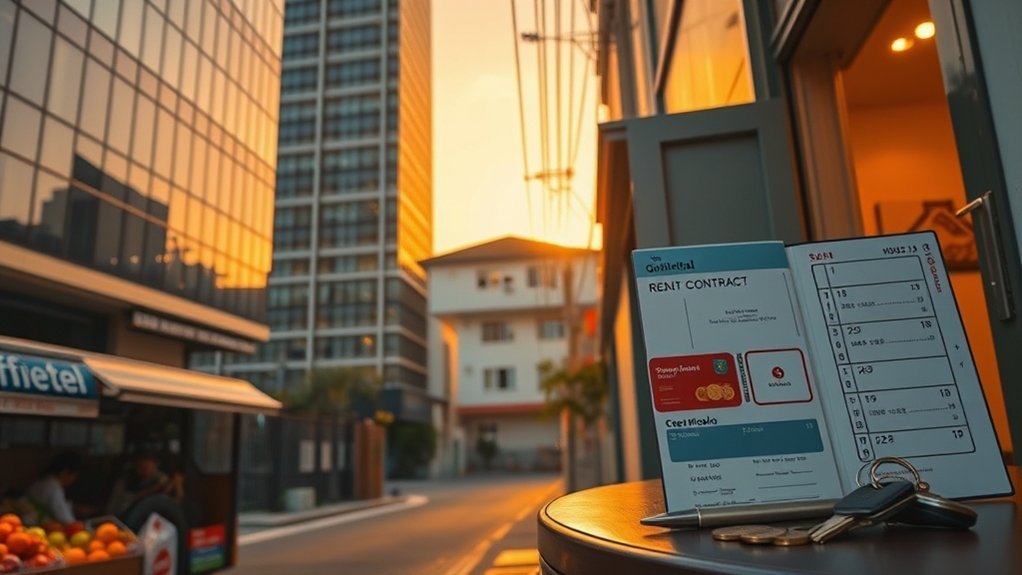
Now that you’ve seen how rent and deposits dominate monthly budgets, let’s look at the specific housing options you’ll encounter in Seoul. You’ll choose between high-deposit Jeonse and monthly-rent Wolse, plus smaller alternatives like officetels and goshiwons depending on budget and location. Compare these data points to plan housing costs.
- Jeonse: large lump-sum deposit (often 50–80% of property), no monthly rent; typical smaller-unit deposits ₩50,000,000–₩100,000,000; refund at lease end.
- Wolse: lower deposit, pays monthly rent; expect one-bedroom city-center around ₩1,300,000 and outside-center ≈₩790,000; Gangnam two-bed >₩2,500,000.
- Officetels: studio-style, budget-friendly for students/commuters; monthly rent roughly ₩300,000–₩1,000,000 depending on location and services.
- Goshiwons: ultra-budget, tiny rooms; lowest-cost Seoul housing option for very tight budgets.
Use these numbers to weigh liquidity (deposit) versus ongoing monthly rent when choosing Seoul housing.
Utilities, Internet and Mobile Plans
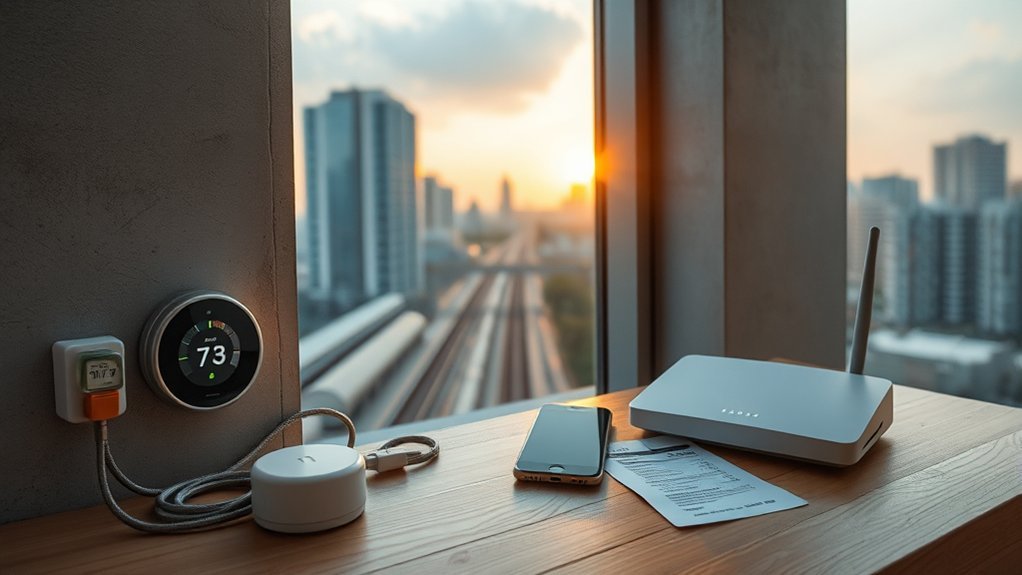
You’ll typically pay ₩30,000–₩90,000 a month for combined utilities, internet and mobile depending on usage and speed.
Home internet runs from about ₩41,800 for KT’s 1 Gbps to ₩99,000 for LG U+’s 10 Gbps (SK offers 2.5 Gbps around ₩57,200).
Mobile plans span roughly ₩33,000 (10 GB) to ₩88,000 (unlimited), with global eSIMs like Holafly starting at $49.90 for 25 GB. Additionally, understanding construction costs can aid in effective budgeting for your living expenses.
Monthly Utility Costs
How much will utilities, internet and mobile plans add to your monthly budget in Seoul? Utilities in Seoul typically put a one-person household at about 100,000–150,000 KRW monthly for electricity, water, heating and garbage, fluctuating with season and consumption. You should then add internet and mobile plans based on needed speed and data. Consider these typical costs:
- Utilities (electricity, water, heating, garbage): 100,000–150,000 KRW/month.
- Home internet (1 Gbps–10 Gbps): ~41,800–99,000 KRW/month.
- Mobile plans: ~33,000–88,000 KRW/month depending on data/unlimited calls.
- Combined baseline (one-person): expect 100,000–150,000 KRW, rising with high-speed internet or premium mobile plans.
Home Internet Plans
Looking for reliable, high-speed internet in Seoul? You’ll find Seoul internet plans built on fibre-optic networks offering fixed internet at speeds from 1 Gbps to 10 Gbps. If you want budget 1 Gbps service, KT’s plan runs about USD 41.80/month.
For faster home connections, SK Broadband offers 2.5 Gbps around USD 57.20/month, while LG U provides top-tier 10 Gbps service near USD 99.00/month. Choosing depends on household use: single users or light streaming can stick with 1 Gbps; heavy streamers, remote workers, or households with many devices benefit from higher tiers.
Installation and contract terms vary, so compare upfront fees and promotional discounts. These monthly cost benchmarks help you budget realistic broadband expenses in Seoul.
Mobile Data & Prices
Wondering how much mobile data will cost in Seoul? You’ll find clear options from local mobile carriers and global SIM/eSIM providers, so plan comparison is useful. Typical monthly cost examples:
- SKT: ~₩33,000/month for 10 GB — good basic data plan.
- KT: ~₩60,000/month for 50 GB — mid-tier data pricing.
- LG U+: ~₩88,000/month for unlimited data and calls — premium 5G option.
- Holafly eSIM: $49.90 for 25 GB or $64.90 unlimited — convenient for travelers with 5G support.
You’ll choose between local SIMs for long-term savings or eSIMs for short trips. Data plans, 5G coverage, and monthly cost vary; compare based on usage, tethering needs, and roaming avoidance.
Food and Grocery Costs: Eating Out Vs Cooking at Home
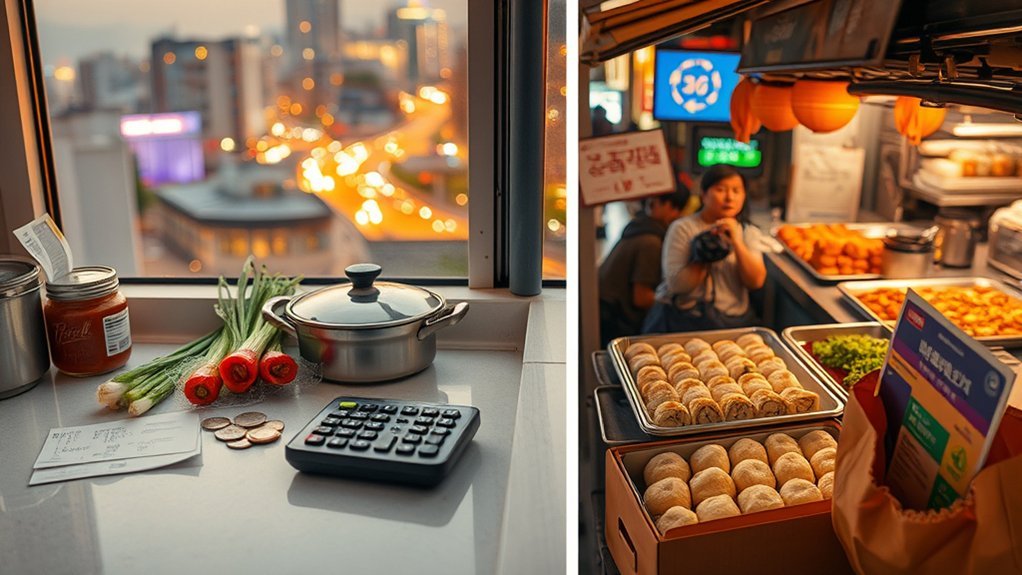
Curious whether you’ll save more by cooking at home or eating out in Seoul? Look at the Seoul cost of living for food: eating out is affordable for many daily meals. Restaurant meals like breakfast often run ₩5,000–₩8,000, lunch sets ₩10,000–₩15,000, and mid-range dinners ₩25,000–₩40,000; street food is often under ₩5,000. Affordable restaurant meals range ₩8,000–₩12,000, while convenience store bentos cost ₩4,000–₩7,000. Café drinks are about ₩4,000–₩6,000, and Korean BBQ sits at ₩15,000–₩30,000 per person.
If you cook at home, groceries per week for basics are cheaper: milk ₩3,000–₩3,500/L, eggs about ₩7,500/dozen, rice around ₩5,000/kg. Use these items plus vegetables and protein to estimate a monthly food budget. Generally, frequent dining out increases your food prices significantly; cooking at home keeps your monthly food budget lower and more predictable, especially if you buy staples and limit café and restaurant meals. Additionally, average expenses for purchasing groceries can vary based on local markets and availability.
Transportation: Subways, Buses, Taxis and Long-Distance Travel
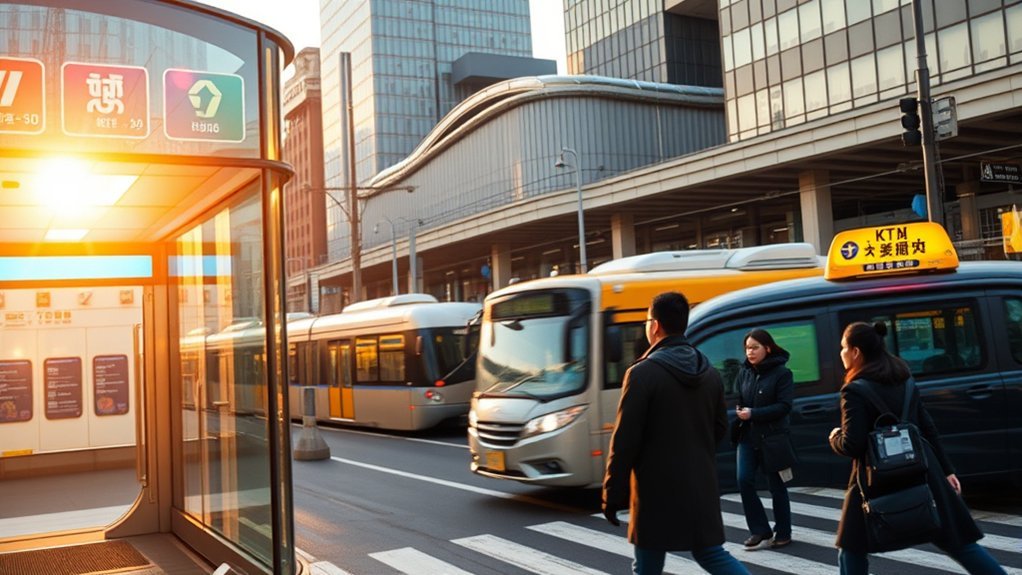
Getting around Seoul is affordable: subway and bus trips typically cost 1,250–1,500 KRW each, and a monthly pass runs about 55,000 KRW. Use a T-money or Cashbee card for transfer discounts and easier payments, while taxis start at roughly 4,000 KRW with late-night surcharges. For intercity travel, KTX trips to cities like Busan are about $45–50 one-way. Additionally, be aware that operational expenses such as transportation costs can significantly impact overall budgeting for services in various sectors, including group homes.
Subway and Bus Fares
How much will you pay to get around Seoul by subway or bus? You’ll find subway fares and bus fares start around 1,250–1,500 KRW per ride, rising with distance. Use a transport pass like T-money or Cashbee to save: cards give transfer discounts and simple tap-and-go across Seoul public transport. A monthly transportation pass typically costs about 55,000 KRW if you commute daily.
- Single ride: ~1,250–1,500 KRW (longer = more)
- Transfer discounts: automatic with T-money/Cashbee
- Monthly transport pass: ~55,000 KRW
- Shared bikes: 1,000 KRW/day or 5,000 KRW/month
Plan trips with cards to cut costs and avoid cash; they streamline transfers and fares.
Taxi Pricing Basics
Wondering when a taxi makes sense in Seoul? You’ll weigh convenience against transportation cost: taxi base fare starts around 4,000 KRW, and a taxi late-night surcharge applies after 10:00 PM, so short nocturnal trips can be notably pricier than daytime.
By contrast, public transit subway fare and bus fare typically run 1,250–1,800 KRW per ride depending on distance.
If you ride frequently, transit passes like Tmoney or Cashbee cost about 55,000 KRW monthly and offer transfers and discounts that lower per-trip cost.
Use taxis for luggage, time-sensitive trips, or group rides; rely on subways/buses plus transit cards for routine commuting.
Track exact fares with apps to compare real-time taxi vs. public transit prices.
Intercity/Long-Distance Trains
Want to travel between Seoul and other major cities quickly? The KTX high-speed service cuts long-distance travel times and fits Seoul transportation needs: a typical KTX trip to Busan costs about $45–$50, a competitive train fare compared with flights. You’ll rely on an efficient rail system that complements subways, buses and taxis within cities. Consider these practical points:
- KTX intercity trains: fast, frequent connections; ideal for business or weekend trips.
- Train fare to Busan: ~$45–$50 one-way; book early for best prices.
- Integration with public transit: use Tmoney to transfer between rail, subway and buses for discounts.
- Travel cost planning: compare KTX vs. regional trains and buses for savings.
Healthcare, Insurance and Medical Costs
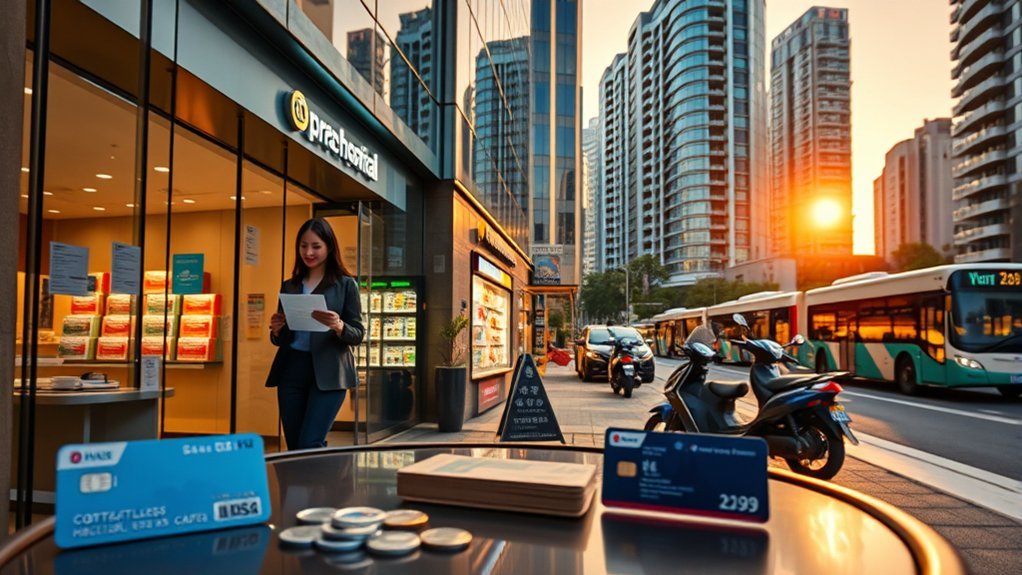
Curious what healthcare in Seoul will mean for your budget? NHIS enrollment is required to access subsidized healthcare; expect monthly minimum premiums for foreigners around ₩113,050, though it varies by income and plan. With NHIS subsidies, general doctor visits typically cost about ₩20,000. You’ll find hospitals efficient, with clear pricing, but major procedures and MRI scans can be costly without extra coverage—private hospital surgeries like appendicitis may run ₩10–18 million. Additionally, understanding potential hidden costs in medical expenses can help you better prepare your budget.
You’ll likely weigh private insurance to fill gaps: plans commonly cost roughly $4,000–$12,000 per year depending on age and coverage. Routine out-of-pocket expenses include private dental cleaning at ₩80,000–₩150,000. Compare premiums, covered services, and co-pays to decide if private insurance reduces your overall medical costs. Use NHIS as the foundation for essential care and consider targeted private policies for high-cost items like MRIs, surgeries, or international coverage.
Entertainment, Shopping and Leisure Expenses

How much you’ll spend on leisure in Seoul depends on the experiences you choose: a standard cinema ticket is about ₩12,000 while premium formats run ₩15,000–₩20,000, big theme parks charge around ₩62,000–₩64,000, and major historic sites like Gyeongbokgung cost roughly ₩3,000.
You can mix lower-cost cultural visits with pricier attractions: Seoul entertainment spans free strolls to full-day park tickets. Consider typical prices and frequency to estimate monthly leisure costs.
- Cinema tickets: ₩12,000 (standard) to ₩15,000–₩20,000 (IMAX/4DX).
- Theme parks & major attractions: Everland ₩64,000, Lotte World ₩62,000, Busan Aquarium ₩29,000, Seoul Grand Park Zoo ₩5,000.
- Nightlife & activities: Noraebang roughly ₩1,500 for 3 songs; vary by venue.
- Ongoing access: streaming services add monthly fees that affect leisure costs.
Additionally, operational expenses such as utilities and staff salaries can significantly impact your budget for entertainment activities. Use these data points to plan realistic entertainment budgets in Seoul entertainment markets.
Money-Saving Tips and Budgeting Strategies
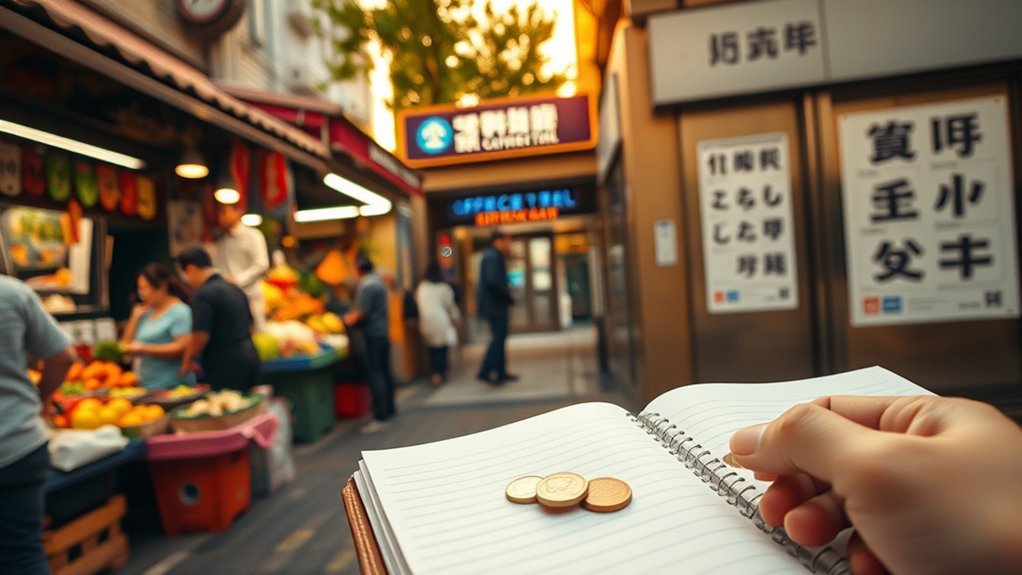
Where can you trim costs without sacrificing comfort? Start by rethinking rent: consider living outside the city center where a one-bedroom averages 790,673 KRW versus 1,308,095 KRW downtown, or explore Jeonse to eliminate monthly rent by paying a large deposit. Track monthly expenses with a simple spreadsheet: list rent, utilities (≈215,012 KRW for a 915 sq ft unit), internet (≈29,052 KRW), and mobile (33,000–88,000 KRW). Cut utilities by monitoring heating/cooling and choosing energy-efficient appliances.
Optimize transport: use T-money for transfers and buy a monthly pass (~55,000 KRW) if you commute frequently; avoid taxis except when necessary (base fare ~4,000 KRW). Reduce groceries by shopping markets and cooking—weekly costs run about $50–100 for one person—and limit dining out to affordable meals (8,000–12,000 KRW). Setting realistic budgeting targets for each category and reviewing them monthly to keep Seoul living costs predictable and controllable can lead to significant savings on transportation expenses.
Frequently Asked Questions
How Much Does It Cost to Live in Seoul With Rent?
Expect to pay about $700–$2,500+ monthly including rent and utilities depending on location; central Seoul hits higher ranges, outskirts drop to $300–$1,000 for rent, and add deposits or jeonse arrangements accordingly.
Is Seoul Expensive for Americans?
Yes — it depends on your choices: think of Seoul as a balance scale. You’ll find cheaper housing outside center, modest utilities, and affordable local food, but central rent or Western habits can push costs much higher.
What Is a Good Salary to Live in Korea?
A good salary in Korea is about USD 2,500–3,500 monthly (3–4 million KRW) for comfortable living in Seoul; you’ll need less (2–2.5 million KRW) outside the center, with higher amounts for family needs.
How Much Is an Apartment in Korea in US Dollars?
You’ll pay about $486–$833 monthly for a one-bedroom, $700–$2,500+ for typical central options, and Gangnam two-bedrooms can exceed $2,500; deposits vary (Jeonse 50–80% or Wolse smaller deposit plus rent).
Conclusion
You’ll likely spend more than you expect, but Seoul’s costs are predictable if you plan. Data shows rent and food take the biggest share, while transport and healthcare remain affordable with insurance and monthly passes. Test the theory that “moving smart saves 30%”: compare Jeonse or shared officetel options, cook more, use public transit and cap entertainment. Do that for three months and you’ll see real savings — then adjust your budget confidently.

